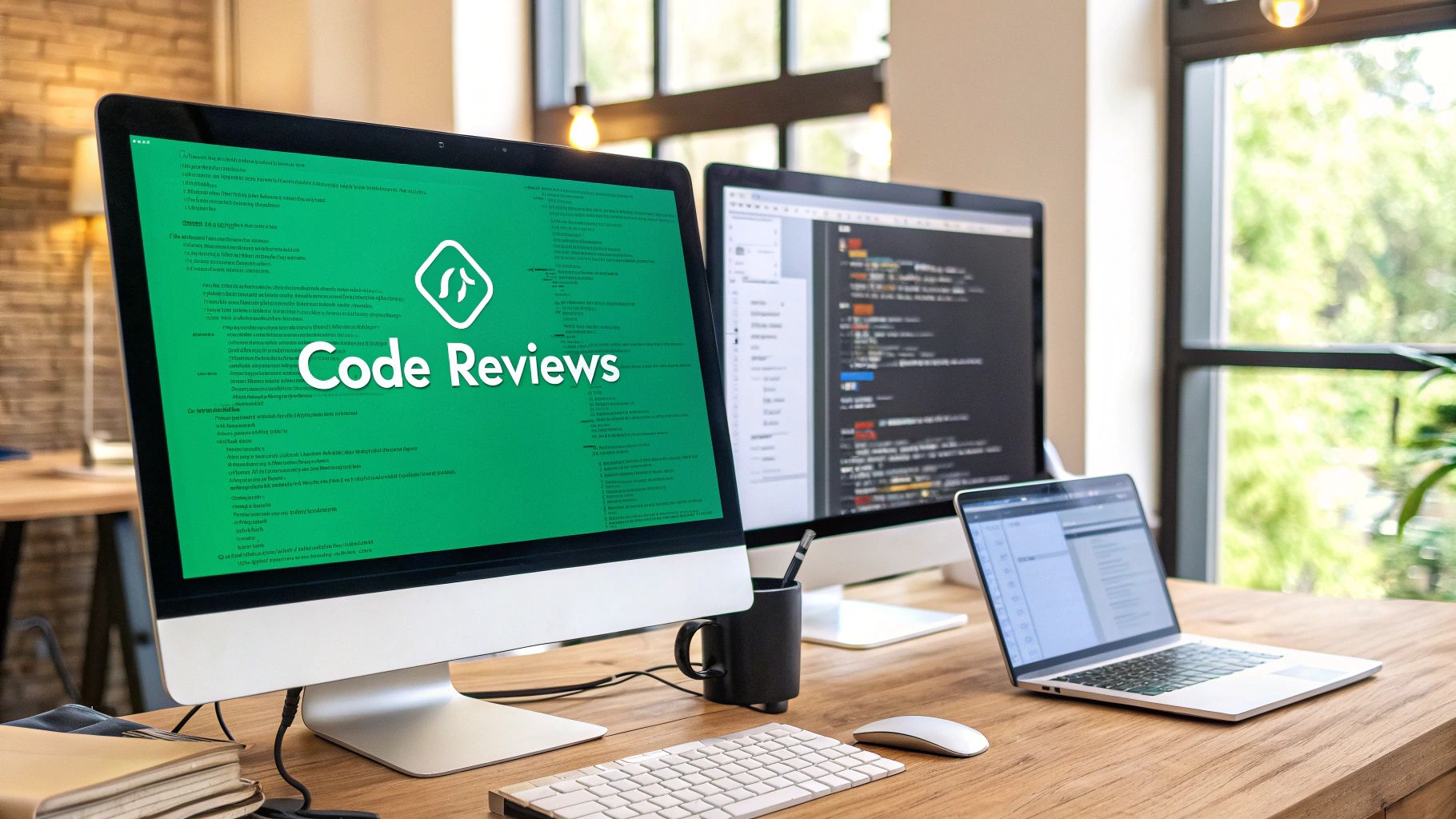Master proven version control best practices that drive measurable results for development teams. Learn battle-tested strategies for workflows, security, and collaboration that actually work.

The success of any software development team depends heavily on their version control practices. Going beyond just picking a system, teams need to consider their workflows, collaboration needs, and security requirements. Let’s explore the key aspects of implementing effective version control.
When it comes to version control systems, Git dominates the field with an 89.40% market share in 2024. This widespread adoption brings major benefits - extensive community support, abundant learning resources, and a large pool of experienced developers. Git’s popularity stems from its practical advantages. For instance, its distributed architecture lets developers work offline and contribute remotely, which perfectly matches how modern teams collaborate.
Many teams hold back from fully using version control because they worry it’s too complex or will disrupt their current way of working. This caution ends up limiting their ability to work together smoothly and track changes effectively. The solution is to start small - begin with the basics and gradually add more advanced features as your team gets comfortable. It’s similar to picking up any new skill - you start with fundamentals and build up over time through regular practice.
The most effective teams follow certain key practices to get the most from their version control system. One important approach is making atomic commits - grouping related changes together in a single commit. This prevents partial updates that could break the code. Think of it like following a recipe - you need all the ingredients combined properly for the dish to work. Teams should also write clear commit messages and link changes to specific tasks or bug reports, which helps everyone understand the context and purpose of each update.
Version control isn’t just for code - it’s equally important for documentation. With countless documents being created each year, keeping one definitive version is critical. Using version control for docs prevents the confusion of multiple versions floating around and makes updates simpler by ensuring everyone can access the latest information. This is particularly important in regulated industries that require strict documentation control. Teams also need proper access controls and security measures to protect sensitive information in their repositories. These fundamentals create the foundation for smooth collaboration, which we’ll discuss in the next section.
Good version control workflows are the foundation of successful team collaboration and project management. Creating effective workflows requires more than picking a branching model - it requires clear protocols that your whole team can understand and follow consistently. As projects grow in size and complexity, these workflows need to scale smoothly while maintaining order.
The branching strategy you select needs to match your specific project requirements. While Git provides many options, certain approaches work better in different situations. Take Gitflow, for example - its separate branches for development, features, releases, and bug fixes work great for large projects with planned release cycles. But smaller projects may benefit more from the simplicity of GitHub Flow, where feature branches merge straight into main. Picking a strategy that doesn’t fit your needs can slow down development and create confusion, so it’s important to understand what works best for your situation.
Your commit messages tell the story of your project’s development over time. Clear and informative commit messages aren’t just good practice - they’re essential for teamwork and troubleshooting. Think about trying to understand a code change from months ago with just a vague message like “fixed bug”. That would waste valuable time figuring out what actually changed. Instead, use structured approaches like conventional commits that start with descriptors like “feat:”, “fix:”, or “docs:” to immediately show what the commit does. This helps both you and your teammates quickly grasp the context of changes.
A well-organized commit history makes it easier to read code changes and track down issues. But keeping things clean shouldn’t get in the way of getting work done. Smart approaches like squashing commits before merging feature branches can help create a cleaner history without forcing developers to perfect every single commit as they work. This gives you an easy-to-follow history while still allowing quick commits during active development. A tidy history also makes code reviews more productive since reviewers can focus on the actual changes rather than trying to piece together a confusing commit trail.
Merge conflicts will happen when multiple people work on the same code. Having clear steps for resolving these conflicts is key. For example, when conflicts come up, developers should talk directly with each other instead of just using automated fixes. This prevents accidental breaks and helps share knowledge across the team. Regular pulls from the main branch into feature branches also help by catching conflicts early when they’re still small and manageable. Building these practices into your workflow creates a strong foundation for successful projects.


Good security practices need to be tightly integrated with version control from day one, not added as an afterthought. The good news is that you can implement strong security measures while keeping your development workflow fast and efficient.
Think of access control like building security - different people need different levels of access to do their jobs effectively. Just as bank tellers can access cash drawers but not the vault, your team members should have permissions tailored to their roles. Developers, testers, and project managers each get the specific access they need to do their work - nothing more, nothing less. This minimizes risk while maintaining productivity. When someone accidentally gains too much access, it’s like leaving the bank vault door open - a serious security risk that’s easily preventable with proper controls.
Keeping secrets safe is critical for any codebase. API keys, database credentials, and private keys should never end up directly in your repository. Instead, use environment variables or dedicated tools designed for secrets management. Make it a habit to regularly check your repositories for any accidentally committed sensitive data. It’s like checking your house for unlocked doors and windows - a simple routine that prevents major problems. Taking these basic precautions helps avoid costly security incidents while keeping your code clean and secure.
For teams working in regulated industries, compliance is non-negotiable. But it doesn’t have to create endless red tape. Smart version control practices actually make compliance easier by providing clear audit trails and access records. Rather than slowing things down, proper version control gives you the documentation you need to demonstrate compliance quickly. This means your team can focus on building great software instead of drowning in paperwork.
Manual security reviews are like trying to proofread a novel without spellcheck - slow, tedious, and prone to missing things. That’s why successful teams use automated tools to scan code for vulnerabilities, enforce standards, and detect exposed secrets. By building security checks into your workflow, you catch issues early while keeping development moving quickly. Think of it like having a security guard that works 24/7 without taking breaks. The goal is to make security automatic and invisible - protecting your code without getting in the way of shipping features.

Code reviews are a key practice for building better software together as a team. When integrated thoughtfully into your development workflow, they help catch issues early, share knowledge across the team, and improve code quality. The key is setting up a review process that adds value without becoming a bottleneck. By incorporating reviews into your version control practices, you can create an efficient system that helps your team collaborate effectively.
Just like having standards for commit messages, clear guidelines for code reviews help everyone know what to expect. Your team should define what reviewers should focus on - like functionality, security considerations, and adherence to coding standards - rather than getting caught up in personal style preferences. For example, you might specify that reviews should examine error handling, test coverage, and potential performance impacts, while being flexible about minor formatting choices. Having this shared understanding keeps reviews focused on what matters most.
Tools like Git, which dominates version control with 89.40% market share in 2024, provide features specifically designed for collaborative code review. Pull requests create a dedicated space to propose, discuss and track changes. This structured approach prevents work from falling through the cracks, especially with larger teams or remote contributors. The history and discussion thread also serve as valuable documentation of why certain technical decisions were made.
The way feedback is given makes a big difference in how it’s received. Reviews work best when focused on improving the code together rather than criticizing the author. Simple changes in phrasing can help - instead of “This code is messy,” try “We could make this clearer by breaking it into smaller functions.” When reviewers take a collaborative tone, developers are more likely to engage constructively with the feedback. For more tips on effective reviews, check out our guide on How to master code review best practices and streamline your workflow.
Sometimes developers will disagree about the best approach during code reviews. Having an established process for resolving conflicts helps prevent these situations from becoming blockers. This could mean designating a technical lead to make final calls, or setting up quick sync meetings to work through complex issues together. The goal is addressing disagreements promptly and professionally while keeping the review process moving. Regular check-ins on how reviews are working for the team provide chances to refine guidelines and prevent future friction points.
In software development, documentation management is just as vital as code management but often gets overlooked. Clear, well-organized documentation helps teams work together smoothly, lets new members come up to speed quickly, and keeps projects running well over time. The sheer volume of documentation produced each year only reinforces the need for smart version control practices.
When documentation lives alongside code in the same version control system, it naturally becomes part of the development workflow. This unified approach makes perfect sense - you can update both code and docs in a single commit, keeping everything in sync. Using familiar tools like Git (which handles nearly 90% of version control needs) means teams don’t have to learn new systems. Just as developers make focused code commits, they can bundle related documentation changes together to maintain clarity.
Having documentation scattered across emails and shared drives is a recipe for confusion. Version control solves this by creating one central place where teams can find the latest, approved versions of all documents. Think of it like a well-organized library - you know exactly where to look for the current version of any book. This becomes especially important in regulated industries where documentation accuracy directly impacts compliance.
The key to keeping documentation fresh is making updates easy and natural for team members. Simple steps help a lot: requiring doc updates with code changes in pull requests, providing clear style guides (just like coding standards), and recognizing team members who contribute to documentation. When the process feels smooth rather than burdensome, people are more likely to keep docs current.
Smart automation can take much of the manual work out of documentation maintenance. For example, API documentation generators can pull directly from code comments to ensure docs and implementation stay matched. Adding automated checks for documentation standards catches issues early, similar to how code tests prevent bugs from spreading. With these practices in place, documentation naturally evolves alongside your code, giving teams reliable information throughout the project’s life.
Getting a team to adopt and stick with version control best practices takes more than just understanding the concepts. The key is combining careful planning with steps that make sense for your specific team’s needs. Let’s explore how to get teams to not just learn these practices, but actually use them consistently in their daily work.
When introducing new workflows, it’s normal for teams to push back. After all, developers who have spent years working a certain way may see new practices as unnecessary overhead. For example, teams used to making large, infrequent commits often view atomic commits as extra busywork that slows them down.
The solution lies in clear communication about concrete benefits. Show how atomic commits make debugging much easier - instead of searching through hundreds of lines in a massive commit, developers can quickly identify and fix issues by looking at small, focused changes. Back up these points with real examples from your codebase where smaller commits would have saved time and headaches.
For changes to stick long-term, the team needs to feel ownership over the new practices. Rather than dictating changes from above, bring developers into the conversation early. Run interactive workshops where the team can discuss version control approaches, raise concerns, and suggest modifications that would work better for their workflow.
Consider starting with a pilot project to test out new practices. Pick something smaller and lower-stakes where the team can experiment freely. This creates a safe space to work out issues before rolling changes across the full organization. The successful results then provide evidence to convince other teams.
To evaluate if new practices are actually improving things, you need clear metrics. Focus on numbers that directly impact developer productivity and code quality. Track things like:
A drop in merge conflicts shows that branching strategies are working. Faster code reviews indicate that better commit messages and organization are paying off. Regular measurement helps identify what’s working and what needs adjustment.
Think of implementing version control practices as an ongoing process rather than a one-time change. Start with the highest-impact items like establishing clear branching patterns and commit message guidelines. Provide training resources and regular check-ins to help the team adapt. Keep communication channels open to quickly address any roadblocks that come up.
Ready to make documentation easier while helping your development team work more efficiently? DocuWriter.ai provides AI-powered tools to automate code and API documentation, giving your team more time to focus on writing great code.